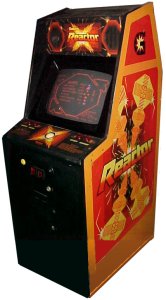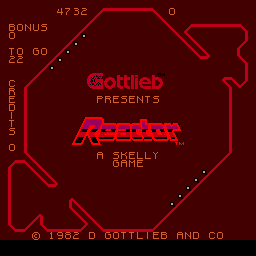 The Game: In a bizarre combination of pinball, zero gravity, and nuclear physics, you pilot your “ship” around a reactor chamber, trying to eliminate rogue radioactive particles (which are about the same size as your ship). Anything touching the outer walls of the chamber will be destroyed, including your on-screen alter ego. Two pairs of five rods can be used to cool down the ever-expanding nuclear reaction at the center of the screen, but you can only push the rods in by bumping the particle into them head-on. Trapping particles in either of two cul-de-sacs in the upper right and lower left corners of the playing field will earn you bonus points, and the best way to accomplish this is to plant one of your limited number of decoys at the entrance to one of the smaller areas. In early levels, you can keep your back to the reactor and hug it as you bounce the particles off of it, but in later levels, the reactions are exposed and become just as deadly to you as to the walls are. (Gottlieb, 1982)
The Game: In a bizarre combination of pinball, zero gravity, and nuclear physics, you pilot your “ship” around a reactor chamber, trying to eliminate rogue radioactive particles (which are about the same size as your ship). Anything touching the outer walls of the chamber will be destroyed, including your on-screen alter ego. Two pairs of five rods can be used to cool down the ever-expanding nuclear reaction at the center of the screen, but you can only push the rods in by bumping the particle into them head-on. Trapping particles in either of two cul-de-sacs in the upper right and lower left corners of the playing field will earn you bonus points, and the best way to accomplish this is to plant one of your limited number of decoys at the entrance to one of the smaller areas. In early levels, you can keep your back to the reactor and hug it as you bounce the particles off of it, but in later levels, the reactions are exposed and become just as deadly to you as to the walls are. (Gottlieb, 1982)
Memories: A decidedly weird but incredibly addictive game. You may find yourself spending ages on it before you know it, and getting better and better at the game. This is a game which would probably be a hit in a graphically updated edition – providing the game play was left as is. Then again, adding detailed graphics would probably rob Reactor of a lot of its mystique.
 Adding to Reactor‘s abstract nature is its strange electronic music. Whereas games like the Pac-Man family utilized music that essentially sounded like an electronic calliope, Reactor uses very abstract sounds, which were probably an attempt to emulate the sound of an electric guitar with a heavy distortion effect. The game opens with an instructional screen detailing Reactor‘s oddball rules and
Adding to Reactor‘s abstract nature is its strange electronic music. Whereas games like the Pac-Man family utilized music that essentially sounded like an electronic calliope, Reactor uses very abstract sounds, which were probably an attempt to emulate the sound of an electric guitar with a heavy distortion effect. The game opens with an instructional screen detailing Reactor‘s oddball rules and  cast of characters – so to speak – with an awesome, thumping techno beat.
cast of characters – so to speak – with an awesome, thumping techno beat.
Parker Brothers, with a licensing deal already in place with Gottlieb for Q*Bert, released home versions of Reactor for the Atari 2600 and the ColecoVision. Both of them – even the somewhat blocky Atari edition – were surprisingly good ports.